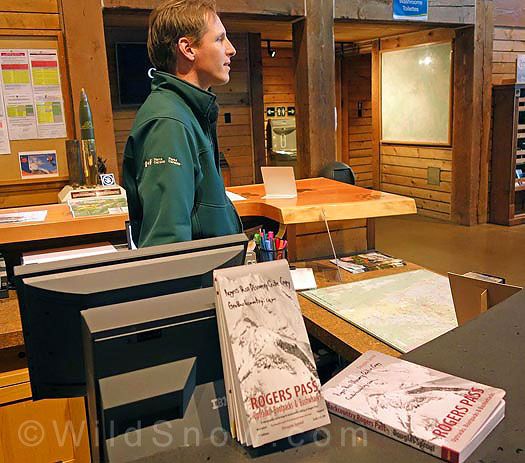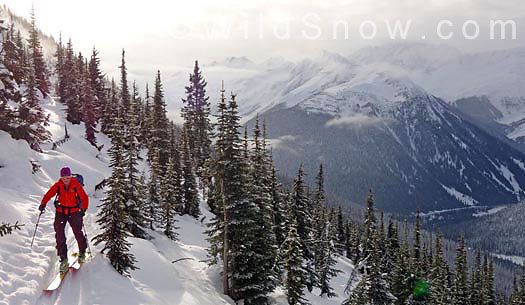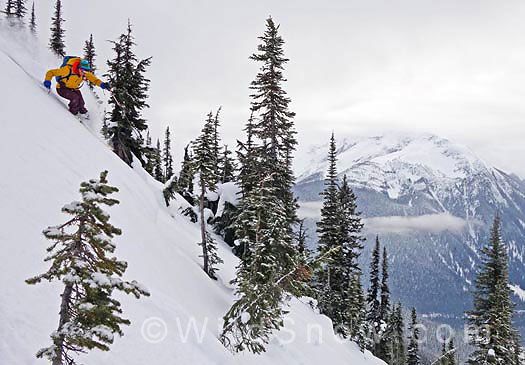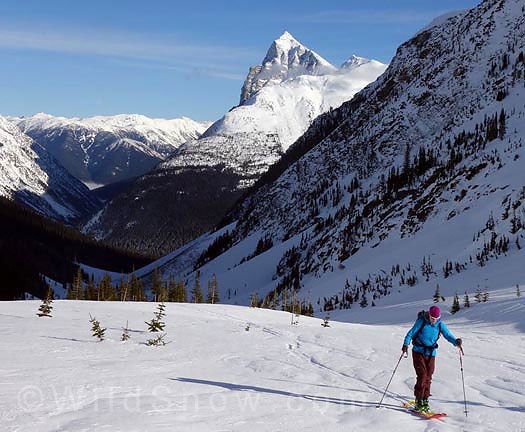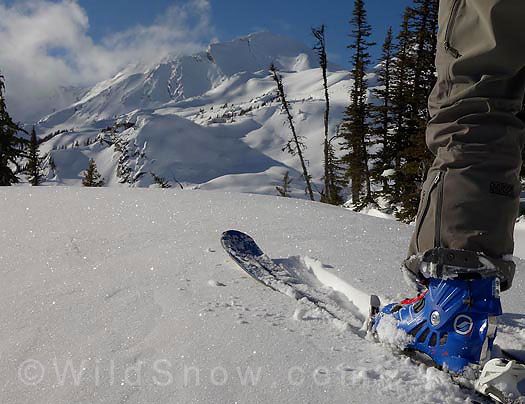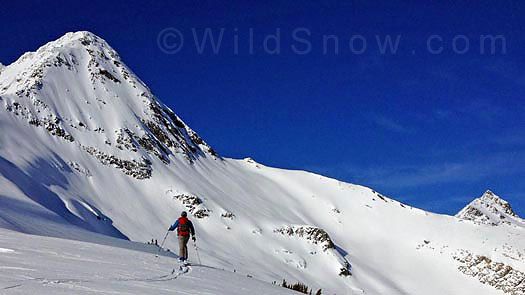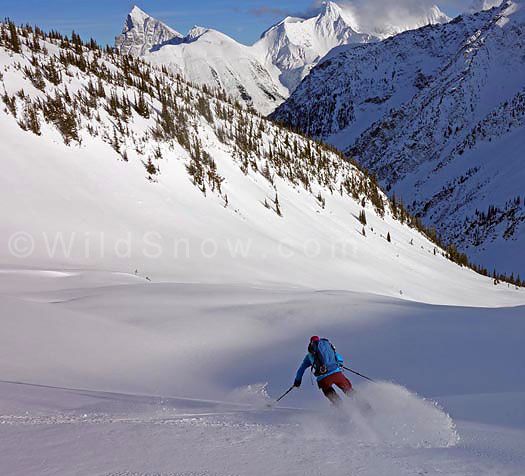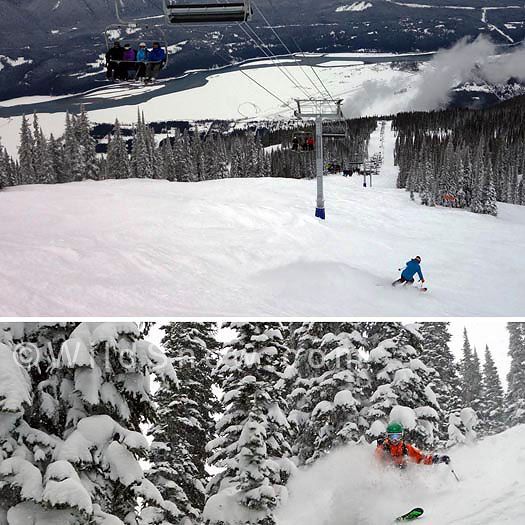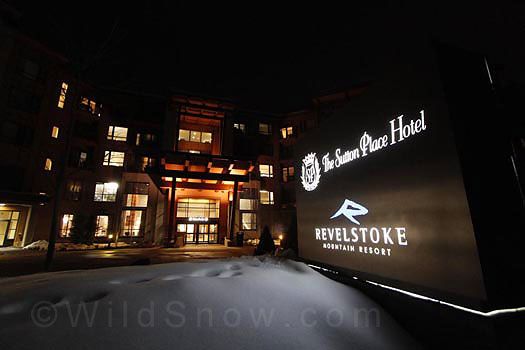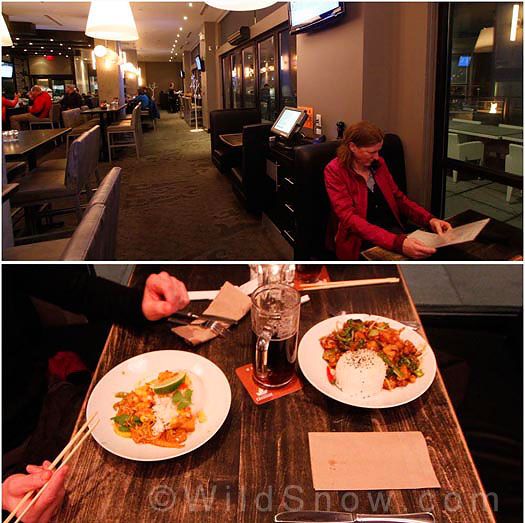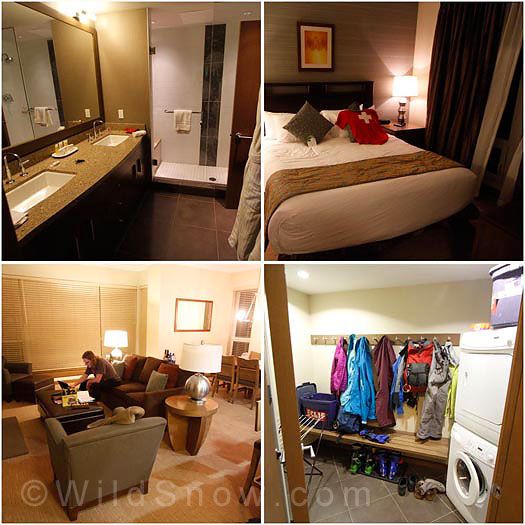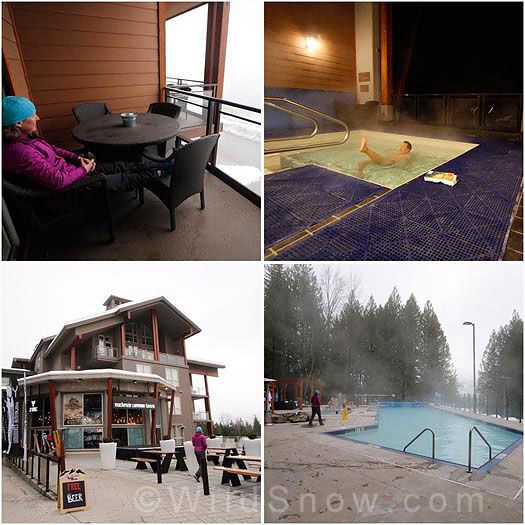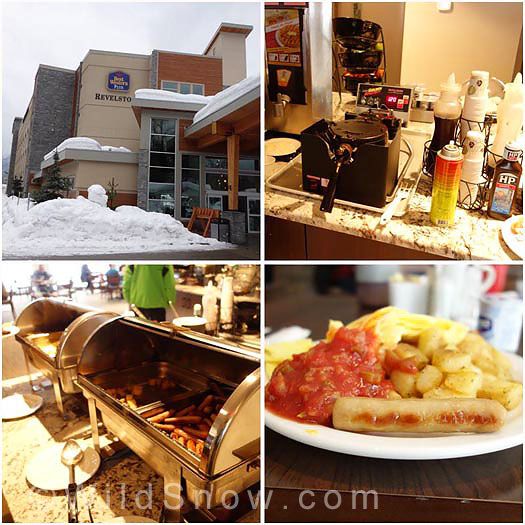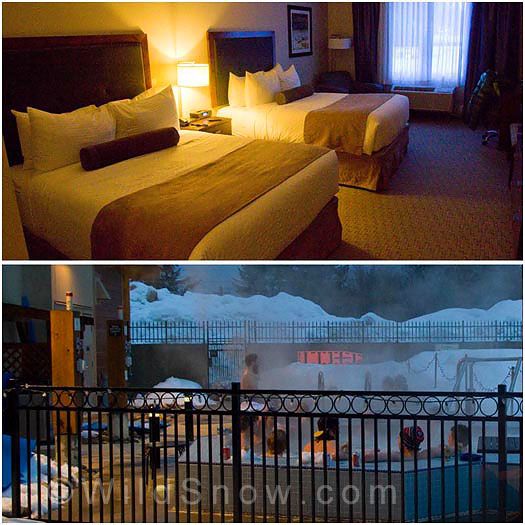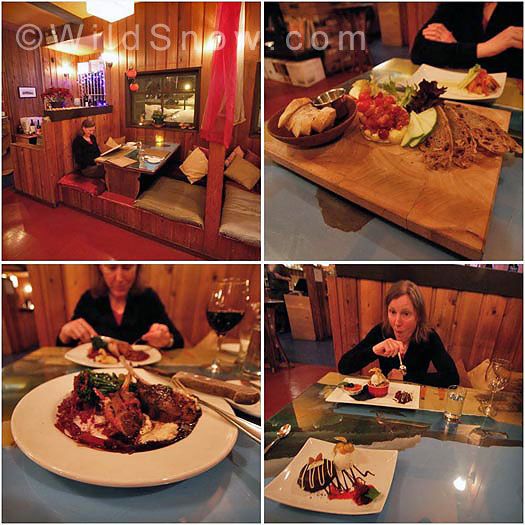Revelstoke! Once thought of as a stop on Canada’s east-west TransCanada Highway, its name has become synonymous with deep snowpacks and skiing. Located just an hour east of “Revy” is Rogers Pass — aka backcountry skiing heaven.
This article showcases some very quick and easy touring opportunities in the Rogers Pass area. For a more indepth look at tours in the Rogers Pass area you would be well-served to read other articles about the Rogers Pass guidebook (authored by Geo Backcountry’s Douglas Sproul) discussed in two parts on Wildsnow (part 1 and part 2). Secondarily this article discusses some of the slackcountry touring options available from Revelstoke’s RMR ski resort.
Rogers Pass
Rogers Pass is located in Glacier National Park in British Columbia, Canada. A major highway winds its way through the park topping out at Rogers Pass at 1330m. The highway winds through the heart of the Selkirks; one of the world’s astoundingly beautiful mountain ranges. From the Pass and from various access points located close to the highway, multiple ski touring zones can be accessed.
Your first stop will likely be to head to the Rogers Pass Discovery Center. Access to many (but not all touring locations) in Glacier National Park (“GNP”) is through a permit system designed to allow for safe travel for backcountry travellers during times of avalanche control. Frequent visitors will get an Annual Permit; something you can also do online if you want to avoid a lineup and wait at the Discovery Centre. Avalanche control in the Pass may result in areas being closed so it is important to check to see what’s open before you go.
The Trans Canada highway through Rogers Pass affords access so you can gain elevation quickly. Unfortunately there are logistical challenges in skiing the Pass. Some of the challenges are due to the usual mix of terrain, snow and avalanche control and consequent closures. Parks Canada can be frustratingly slow in updating closure information, so if you want to ski at the Pass during storm cycles expect to spend a fair chunk of time waiting for information.
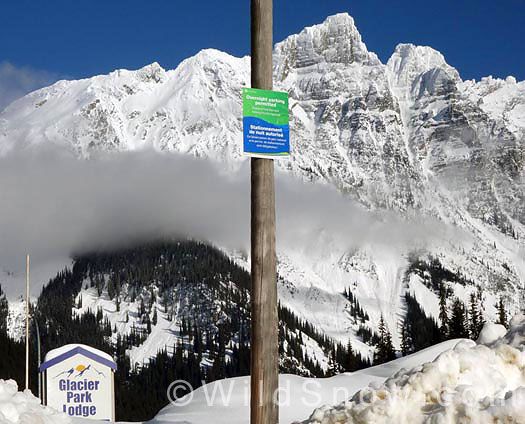
Unfortunately the Glacier Park Lodge is no longer open. Camping overnight is permitted in the Visitor Centre parking lot. You can also stay at the Wheeler and Asulkan huts south of the highway.
Example of a place where a permit is required is the MacDonald/Avalanche areas just E of the Discovery Centre. One look at the NRC Gullies avalanche paths running 1000’s of vertical metres to the highway will tell you why permits are required. A well placed bomb on the slopes could really ruin your day.
One of the attractions of Rogers Pass is the quick approaches and the subsequent ability to ski directly back to the parking lots. The MacDonald/Avalanche area is no exception. In a short time you can climb from 1300m at valley bottom and be above glaciers at 2350m. From this area your can enjoy fine views south towards the Illecillawaet/Great Glacier area, east to the Grizzly/Sifton drainages or north to the Swiss/Tupper area. If conditions permit this has to be one of the best bang-for-the-buck tours in the area. You can then drop over Avalanche Crest to Avalanche Glacier; or north towards Tupper through some spicily steep couloirs and paths, or come right back down where you skinned up. This is just one touring possibility among many in the Rogers Pass area, and a gateway to other tours.
Another popular touring area is the Connaught Creek drainage, one of the few places where a permit is not required for winter travel (along with the Asulkan valley areas). Although these drainages are not winter avalanche controlled it is important to note that by no means does that mean that they’re not exposed to avalanche hazard. In fact the Connaught drainage is vulnerable to multiple slidepaths from many directions.
Despite objective hazard, the Connaught is one of the more popular areas in the Pass so expect to encounter fellow tourers, especially on weekends. Another “gateway” area, the tour to the head of the valley allows you to connect to other longer tours but many will session the more intermediate slopes of Balu Pass.
On this tour we did the milk run to Balu Pass then skied part of the way down W facing slopes towards Cougar Brook till snow quality deteriorated then reversed back on the ridge N of Balu Pass then dropped into 8812 Bowl at its 3/4 mark. There are infinite variations possible.
Revelstoke Mountain Resort
Revelstoke’s RMR ski resort.” target=”_blank”>RMR is Revelstoke’s local ski hill. With 1713 vertical metres of elevation its not just any local ski hill but a worthy sidebar for any ski tourer in the area. Unfortunately during winter storm season the highway to Rogers Pass can often be closed or openings delayed. Fortunately RMR’s lift-system and terrain accessible by a short skin or even hike gives one lots of opportunities to explore. In terms of avalanche awareness and openness of terrain RMR definitely seems to get it. For example, the mountain has an Avalanche Ranch where 8 transceivers are buried so you can practice your beacon skills. RMR also has an open policy towards backcountry travel (tempered by much education) where guests can access more difficult terrain by way of various exit points.
One of the easier to navigate areas are the south bowls into the cat-ski terrain. This area is not avalanche controlled but has an exceptionally conveniently plowed road for cat-ski access. A short skin takes you into the area where you can then ski some 500m sub-alpine into treed shots. Just make sure you up the 1830m contour to skin and traverse back to the resort and in no-time you’ll be getting your fill of quasi-lift-served triple overhead blower pow. Decadent to be sure! Be nice to the cat ski guides and clients and make sure you’re well off the road as they come past you.
An exceptionally convenient service offered is a (Revelstoke) town to resort shuttle (check shuttle schedule here). It’s a nice option to not have to drive and be able to enjoy apres at the Rockford Grill.

RMR inbounds. Looks like everyone ditches their packs at the Stoke Lift, rips inbound laps then collects their when they go for the slackcountry powder shots – so we did the same.
Where to stay and to eat
We were guests at Sutton Place Hotel Revelstoke Mountain Resort. The Sutton Place is palatial and customer service is a premium. It has a couple of hot tubs is obviously as close to RMR as you can get. While a bit removed from town, this means that it is quiet. It only takes an extra 5 minutes to get to the highway if you want to get to Rogers Pass. Once you do the numbers the 2 bedroom suite in the Sutton Place is reasonably priced albeit at the higher end (prices vary through the season but you’d be looking at approx $ 300 – $ 500/night). It’s entirely possible to share the suite with one or two other couples (there’s a pull-out bed) or with a family and cook your own breakfast in their full kitchen.
An alternative to the Sutton if you want to be closer to town is the Best Western. It’s a modern comfortable hotel also served by the town to hill shuttle. Very importantly for ski tourers they have an amazingly huge buffet breakfast and comfortable, warm and quiet rooms. There’s tons of room to spread out and dry your touring gear.
You can’t have enough places to eat. Another place we recommend is the Woolsey Creek Cafe. It’s consistently the top-rated restaurant in the region. We’ve been going here for 14 years and we keep coming back over and over again.
Rogers Pass useful links
(from Geobackcountry’s Rogers Pass North epic guide – thanks to Doug Sproul for permission to reproduce)
Parks Canada
Parks Canada Revelstoke office (250) 837-7500
Parks Canada (Rogers Pass Office) (250) 814-5202
Road Conditions (Banff) (403) 762-1450 (Jasper) (780) 852-3311
Winter Permit Information
Winter Permit System explained
Winter Restricted Area status (250) 837-SKIS (7547)
Weather, Snowpack and Avalanche
Glacier Park Avalanche Bulletin
Glacier Park Avalanche Bulletin (250) 837 – MTNS (6867)
Other information
Weather
BC road conditions
Avalanche advisories for BC highways
Highway webcams
Revelstoke
Macdonald Snowshed East of Revy
Rogers Pass
Golden
Guest blogger Lee Lau is an avid skier and outdoorsman embarking on many adventures with his loving, and sometimes concerned wife, Sharon. He has over 15 years of experience skiing, ski-touring and dabbles in mountaineering. In the “off-season” he is occasionally found working in his day job as an intellectual property lawyer when he is not mountain biking. As a resident of Vancouver, British Columbia, Lee’s playground extends mainly to Western Canada, including South West B.C. and the Selkirks.

